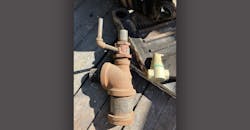Sometimes I arrive at a boiler replacement job site before the scrap is hauled away. I enjoy checking out the old cast iron sections that have been transferring heat for the last 40 years or so. This job was a high efficiency upgrade at an apartment building. I usually show up to go over the piping changes with the installing contractor, and then have lunch.
In the parking lot were both the scrap trailer and the recently delivered new equipment. Twelve or so cast iron sections were laying on the trailer, the remnants of the old boiler. Two fully assembled boilers in boxes were sitting on the ground, the building blocks of future energy savings. The building owner took the option for two boilers instead of one, so there would be redundancy. It’s always nice to have back-up.
On the trailer I also noticed a component of the old air control system. I’m on a streak lately with this old school method, seeing this dip tube air separation on plenty of recent jobs. Dip tube air separation was all the rage before air scoops, tangential air separators, or the current method(s) of air elimination. The science of air control has evolved through the years, like a lot of other hydronic components.
Meet the Dip Tube
On the left side of the picture, the red fitting on top of the very large tee is a Bell & Gossett dip tube air separator. The three inch pipe to the left was connected to the single supply outlet from the boiler, so all the water from the boiler would have it pass through it. This style air separator had to be installed in the piping in a specific way. The old installer went a little over the top.
The way the dip tube air separator works requires it to be in a vertical pipe, with a tee below. The branch of the tee connects to the boiler, the dip tube extends down through the tee inside the nipple and cap on the bottom run of the tee. As the water leaves the boiler, it enters the tee, which is a sudden pipe size increase. That slows the velocity of the water down. We still use that part of the science today.
The air in the water then has a chance to separate and float to the top of the tee, around the outside of the dip tube. The air then moves to an old school expansion tank or an automatic air vent. On this job the ½” line leaving the left side was connected to a standard steel tank in the ceiling of the boiler room.
The system supply water, now freer of air, goes down into the nipple and cap, then up through the inside of the dip tube to heat the building. Air is diverted to the outside of the dip tube while the water flows through the inside of the dip tube. Pretty simple process, but room for interpretation on the install.
Old vs. New
How the old installer went over the top was the pipe sizing—but in a good way. Since he generously oversized that tee, the velocity of the water slows even more for better air separation. I guessing that the expense of that tee alone today would be more than the price of a modern air eliminator (like the one with the green stripe shown in the photo).
The new air eliminators pipe straight in and out, they just have to be in a horizontal pipe, with little restriction on the amount of straight pipe before or after. The cast iron air scoops have to have a long run of straight pipe on the inlet an outlet to keep the water running smooth, or what we call in the trade laminar. When flowing water inside a pipe comes off an elbow, it is turbulent. Turbulent water does not allow the air to separate effectively. I see a lot of air scoops without the correct amount of straight pipe.
The Same, Only Smaller
Most components of hydronic heating have gotten smaller through the years. The original cast iron radiators went from large columns to thin tubes. Radiators were then replaced with convection style radiation like copper fin baseboard that was smaller. Radiant tubing disappeared into the floor, ceiling or wall to comfortably heat our homes.
The original coal-fired boilers on their large bases with huge flue passages shrunk to atmospheric draft gas-fired boilers which then shrunk to high efficiency sealed combustion boilers that the casual observer will claim “It will never work”, but always do. Pipe sizes shrunk as pumps started to do the circulation that gravity once did. Everything’s the same, only smaller.
Patrick Linhardt is a thirty-seven-year veteran of the wholesale side of the hydronic industry who has been designing and troubleshooting steam and hot water heating systems, pumps and controls on an almost daily basis. An educator and author, he is currently Hydronic Manager at the Corken Steel Products Co.
About the Author
Patrick Linhardt
Patrick Linhardt is a forty-one-year veteran of the wholesale side of the hydronic industry who has been designing and troubleshooting steam and hot water heating systems, pumps and controls on an almost daily basis. An educator and author, he is currently Hydronic Manager at the Corken Steel Products Co.
